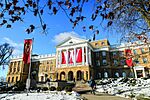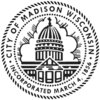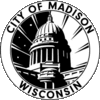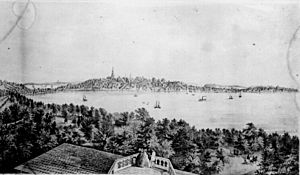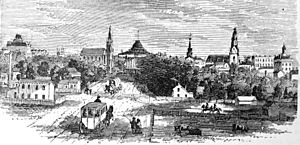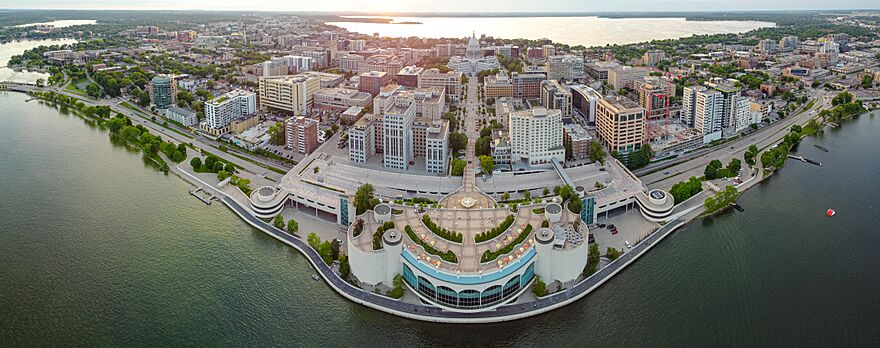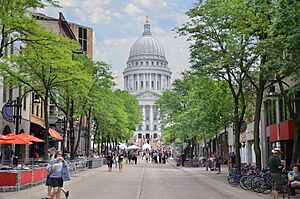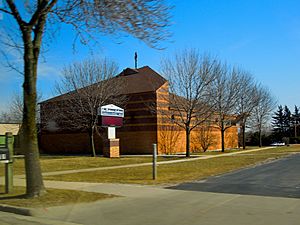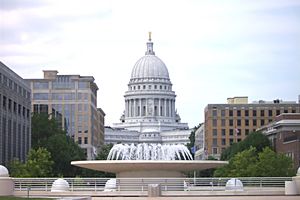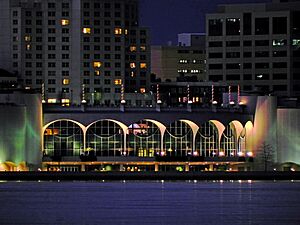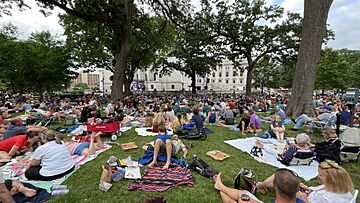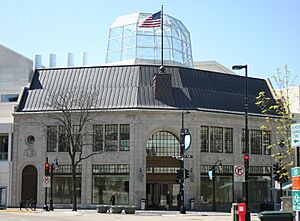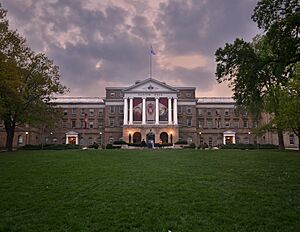Madison, Wisconsin facts for kids
Quick facts for kids
Madison
|
|||||
|---|---|---|---|---|---|
|
Madison Museum of Contemporary Art
|
|||||
|
|||||
| Nickname(s):
Madtown, Mad City, The City of Four Lakes, 77 Square Miles Surrounded by Reality
|
|||||
| Country | United States | ||||
| State | Wisconsin | ||||
| County | Dane | ||||
| Municipality | City | ||||
| Founded | 1836 | ||||
| Chartered | 1846 | ||||
| Incorporated | 1856 | ||||
| Named for | James Madison | ||||
| Government | |||||
| • Type | Mayor-council | ||||
| Area | |||||
| • City | 101.53 sq mi (262.96 km2) | ||||
| • Land | 79.57 sq mi (206.09 km2) | ||||
| • Water | 21.96 sq mi (56.88 km2) | ||||
| Elevation | 873 ft (266 m) | ||||
| Population
(2020)
|
|||||
| • City | 269,840 | ||||
| • Estimate
(2023)
|
280,305 |
||||
| • Rank | US: 77th WI: 2nd | ||||
| • Density | 3,391/sq mi (1,309/km2) | ||||
| • Urban | 450,305 (US: 89th) | ||||
| • Urban density | 3,008/sq mi (1,161/km2) | ||||
| • Metro | 680,796 (US: 87th) | ||||
| • CSA | 910,246 (US: 61st) | ||||
| • Demonym | Madisonian | ||||
| Time zone | UTC−6 (Central) | ||||
| • Summer (DST) | UTC−5 (CDT) | ||||
| Zip Codes |
ZIP Codes
|
||||
| Area code | 608, 353 | ||||
| FIPS code | 55-48000 | ||||
| GNIS feature ID | 1581834 | ||||
Madison is the capital city of the U.S. state of Wisconsin and the county seat of Dane County. The population was 269,840 as of the 2020 census, making it the second-most populous city in Wisconsin, after Milwaukee, and the 77th-most populous in the United States. The Madison metropolitan area had a population of 680,796. The heart of the city is located on an isthmus, and its city limits surround five lakes: Lake Mendota, Lake Monona, Lake Wingra, Lake Kegonsa and Lake Waubesa. Madison was founded in 1836 and is named after American Founding Father and President James Madison.
As the state capital, Madison is home to government chambers including the Wisconsin State Capitol building. The University of Wisconsin–Madison, the flagship campus of the University of Wisconsin System, is located in the city. Other cultural institutions include the Henry Vilas Zoo, Madison Museum of Contemporary Art, Olbrich Botanical Gardens, Overture Center for the Arts, and Wisconsin Historical Museum. Madison is home to an extensive network of parks, the most parks and playgrounds per capita of any of the 100 largest U.S. cities, and is considered a bicycle-friendly community. Madison is also home to nine National Historic Landmarks, including several buildings designed by architect Frank Lloyd Wright, such as the UNESCO World Heritage Site Jacobs I House.
Residents of Madison are known as Madisonians. Madison has long been a center for progressive political activity, protests, and demonstrations, and contemporary Madison is considered the most politically liberal city in Wisconsin. The presence of the University of Wisconsin–Madison, as well as other educational institutions has a significant impact on the economy, culture, and demographics of Madison.
As of 2024, Madison is the fastest-growing city in Wisconsin. Madison's economy features a large and growing technology sector, and the Madison area is home to the headquarters of Epic Systems, American Family Insurance, Exact Sciences, Promega, American Girl, Sub-Zero, Lands' End, Spectrum Brands, a regional office for Google, and the University Research Park, as well as many biotechnology and health systems startups. Madison is a popular visitor destination, with tourism generating over $1 billion for Dane County's economy in 2018.
Contents
History
Madison's origins begin in 1829, when former federal judge James Duane Doty purchased over a thousand acres (4 km²) of swamp and forest land on the isthmus between Lakes Mendota and Monona, with the intention of building a city in the Four Lakes region. When the Wisconsin Territory was created in 1836 the territorial legislature convened in Belmont, Wisconsin. One of the legislature's tasks was to select a permanent location for the territory's capital. Doty lobbied aggressively for Madison as the new capital, offering buffalo robes to the freezing legislators and promising choice Madison lots at discount prices to undecided voters. He had James Slaughter plat two cities in the area, Madison and "The City of Four Lakes", near present-day Middleton.
Doty named the city Madison for James Madison, the fourth President of the U.S. who had died on June 28, 1836 and he named the streets for the other 39 signers of the U.S. Constitution. Although the city existed only on paper, the territorial legislature voted on November 28 in favor of Madison as its capital, largely because of its location halfway between the new and growing cities around Milwaukee in the east and the long established strategic post of Prairie du Chien in the west, and between the highly populated lead mining regions in the southwest and Wisconsin's oldest city, Green Bay in the northeast. Being named for the much-admired founding father James Madison, who had just died, and having streets named for each of the 39 signers of the Constitution, may have also helped attract votes.
Creation and expansion
The cornerstone for the Wisconsin capitol was laid in 1837, and the legislature first met there in 1838. On October 9, 1839, Kintzing Prichett registered the plat of Madison at the registrar's office of the then-territorial Dane County. Madison was incorporated as a village in 1846, with a population of 626. When Wisconsin became a state in 1848, Madison remained the capital, and the following year it became the site of the University of Wisconsin (now University of Wisconsin–Madison). The Milwaukee & Mississippi Railroad (a predecessor of the Milwaukee Road) connected to Madison in 1854. Madison incorporated as a city in 1856, with a population of 6,863, leaving the unincorporated remainder as a separate Town of Madison. The original capitol was replaced in 1863 and the second capitol burned in 1904. The current capitol was built between 1906 and 1917.
During the Civil War, Madison served as a center of the Union Army in Wisconsin. The intersection of Milwaukee, East Washington, Winnebago and North Streets is known as Union Corners, because a tavern there was the last stop for Union soldiers before heading to fight the Confederates. Camp Randall, on the west side of Madison, was built and used as a training camp, a military hospital, and a prison camp for captured Confederate soldiers. After the war ended, the Camp Randall site was absorbed into the University of Wisconsin and Camp Randall Stadium was built there in 1917. In 2004 the last vestige of active military training on the site was removed when the stadium renovation replaced a firing range used for ROTC training.
The City of Madison continued annexations from the Town of Madison almost from the date of the city's incorporation, leaving the latter a collection of discontiguous areas subject to annexation. In the wake of continued controversy and an effort in the state legislature to simply abolish the town, an agreement was reached in 2003 to provide for the incorporation of the remaining portions of the Town into the City of Madison and the City of Fitchburg by October 30, 2022.
Geography
Madison is located in the center of Dane County in south-central Wisconsin, 77 miles (124 km) west of Milwaukee and 122 miles (196 km) northwest of Chicago. Madison completely surrounds the city of Monona, and the villages of Maple Bluff and Shorewood Hills. Madison shares borders with its largest suburb, Sun Prairie, and three other suburbs, Middleton, McFarland, and Fitchburg. Other suburbs include the city of Verona and the villages of Cottage Grove, DeForest, and Waunakee as well as Mount Horeb, Oregon, Stoughton, and Cross Plains.
According to the United States Census Bureau, the city has a total area of 94.03 square miles (243.54 km2), of which 76.79 square miles (198.89 km2) is land and 17.24 square miles (44.65 km2) is water.
The city is sometimes described as The City of Four Lakes, comprising the four successive lakes of the Yahara River: Lake Mendota ("Fourth Lake"), Lake Monona ("Third Lake"), Lake Waubesa ("Second Lake") and Lake Kegonsa ("First Lake"), although Waubesa and Kegonsa are not actually in Madison, but just south of it. A fifth smaller lake, Lake Wingra, is within the city as well; it is connected to the Yahara River chain by Wingra Creek. The Yahara flows into the Rock River, which flows into the Mississippi River. Downtown Madison is located on an isthmus between Lakes Mendota and Monona. The city's trademark of "Lake, City, Lake" reflects this geography. The city's lowest elevation is the intersection of Regas Road and Corporate Drive on the east side, at 836.9 ft (255.1 m). The highest elevation is located along Pleasant View Road on the far west side of the city, atop a portion of a terminal moraine of the Green Bay Lobe of the Wisconsin glaciation, at 1,190 ft (360 m).
Neighborhoods
Local identity varies throughout Madison, with over 120 officially recognized neighborhood associations, such as the east side Williamson-Marquette Neighborhood. Historically, the north, east, and south sides were blue collar while the west side was white collar, and to a certain extent this remains true. Students dominate on the University of Wisconsin campus and to the east into downtown, while to its south and in Shorewood Hills on its west, faculty have been a major presence since those neighborhoods were originally developed. The turning point in Madison's development was the university's 1954 decision to develop its experimental farm on the western edge of town; since then, the city has grown substantially along suburban lines.
Major commercial areas
Hilldale
The Hilldale area comprises the Hill Farms neighborhood, Sunset Village Neighborhood, and part of the suburb of Shorewood Hills. The area has long winding streets, and according to a planning document issued by the neighborhood association, a "suburban-like feel". The area is also a commercial district, and contains Hilldale Shopping Center, an outdoor shopping center containing restaurants and national retail chains.
Capitol Square
The Capitol Square Area is Madison's central business district. It is home to high-rise apartments, restaurants, and shopping outlets. It contains several museums and is home to the Wisconsin State Capitol building and the Monona Terrace. The capitol square holds several public events for the city of Madison including the Dane County Farmers' Market, Concerts on the Square, Taste of Madison and Art Fair on the Square. The area's nightlife is served by several bars and live music venues.
State Street
State Street, which links the University of Wisconsin campus with the Capitol Square, is lined with restaurants, espresso cafes, and shops. Only pedestrians, buses, emergency vehicles, delivery vehicles, and bikes are allowed on State Street. State Street is home to much of the nightlife of the University of Wisconsin–Madison, as it is the location of several bars and performance venues ranging from comedy clubs to multiple large theaters, including the Overture Center, which features local ballets and Broadway touring casts. State Street is also home to Freakfest, the annual Halloween party in Madison. A newer event on State Street is the Madison Night Market occurring four nights during the year.
Park Street
The Park Street Area, located in the south of Madison, contains multiple official neighborhoods, including Burr Oaks and Greenbush. It has been described as the "racially and economically diverse area of Madison". This is especially the case between the Beltline and Wingra Creek. Park Street is home to ethnic restaurants and specialty grocery stores, as well as retail. Residential areas to the sides of Park Street tend to have smaller houses or condos, and a higher density of houses.
Monroe Street
The Dudgeon-Monroe neighborhood neighbors downtown Madison. It is located around Monroe Street, a commercial area which has local shops, coffee houses, dining and galleries. It is home to a neighborhood jazz fest and Wingra Park, where people can rent paddle boats and canoes at the boathouse on Lake Wingra.
Willy Street
The Marquette neighborhood sits on the near east side of Madison. Willy (Williamson) Street contains locally owned shops, restaurants, and entertainment establishments, as well as art galleries, and the Willy Street Co-op. The houses in the Marquette neighborhood fall into two separate historic districts, Third Lake Ridge Historic District and Marquette Bungalow Historic District. The area is also the location of festivals like the Waterfront Festival (June), La Fete de Marquette (July), Orton Park Festival (August), and Willy Street Fair (September). The Willy Street neighborhood is a hub for Madison's bohemian culture. Houses lining the street are often painted colorfully, and the area has several murals.
Climate
Madison, along with the rest of the state, has a humid continental climate (Köppen: Dfa), characterized by variable weather patterns and a large seasonal temperature variance: winter temperatures can be well below freezing, with moderate to occasionally heavy snowfall and temperatures reaching 0 °F or −17.8 °C on 17 mornings annually; high temperatures in summer average in the lower 80s °F (27–28 °C), reaching 90 °F (32.2 °C) on an average 12 afternoons per year, with lower humidity levels than winter but higher than spring. Summer accounts for a greater proportion of annual rainfall, but winter still sees significant precipitation.
| Climate data for Madison, Wisconsin (Dane County Regional Airport), 1991–2020 normals, extremes 1869–present | |||||||||||||
|---|---|---|---|---|---|---|---|---|---|---|---|---|---|
| Month | Jan | Feb | Mar | Apr | May | Jun | Jul | Aug | Sep | Oct | Nov | Dec | Year |
| Record high °F (°C) | 58 (14) |
70 (21) |
83 (28) |
94 (34) |
101 (38) |
101 (38) |
107 (42) |
102 (39) |
99 (37) |
90 (32) |
77 (25) |
68 (20) |
107 (42) |
| Mean maximum °F (°C) | 46.2 (7.9) |
51.3 (10.7) |
67.1 (19.5) |
79.1 (26.2) |
85.6 (29.8) |
91.0 (32.8) |
92.2 (33.4) |
90.4 (32.4) |
87.6 (30.9) |
79.4 (26.3) |
63.9 (17.7) |
50.8 (10.4) |
94.1 (34.5) |
| Mean daily maximum °F (°C) | 27.0 (−2.8) |
31.2 (−0.4) |
43.6 (6.4) |
56.9 (13.8) |
69.0 (20.6) |
78.6 (25.9) |
82.1 (27.8) |
79.9 (26.6) |
72.9 (22.7) |
59.6 (15.3) |
44.8 (7.1) |
32.3 (0.2) |
56.5 (13.6) |
| Daily mean °F (°C) | 19.4 (−7.0) |
23.0 (−5.0) |
34.4 (1.3) |
46.3 (7.9) |
58.1 (14.5) |
68.0 (20.0) |
71.9 (22.2) |
69.7 (20.9) |
62.0 (16.7) |
49.7 (9.8) |
36.7 (2.6) |
25.3 (−3.7) |
47.0 (8.3) |
| Mean daily minimum °F (°C) | 11.8 (−11.2) |
14.9 (−9.5) |
25.1 (−3.8) |
35.8 (2.1) |
47.1 (8.4) |
57.4 (14.1) |
61.6 (16.4) |
59.5 (15.3) |
51.0 (10.6) |
39.8 (4.3) |
28.7 (−1.8) |
18.2 (−7.7) |
37.6 (3.1) |
| Mean minimum °F (°C) | −10.6 (−23.7) |
−5.5 (−20.8) |
4.2 (−15.4) |
21.3 (−5.9) |
32.1 (0.1) |
43.2 (6.2) |
49.9 (9.9) |
48.1 (8.9) |
35.8 (2.1) |
25.3 (−3.7) |
12.2 (−11.0) |
−2.6 (−19.2) |
−13.9 (−25.5) |
| Record low °F (°C) | −37 (−38) |
−29 (−34) |
−29 (−34) |
0 (−18) |
19 (−7) |
31 (−1) |
36 (2) |
35 (2) |
25 (−4) |
12 (−11) |
−14 (−26) |
−28 (−33) |
−37 (−38) |
| Average precipitation inches (mm) | 1.47 (37) |
1.52 (39) |
2.26 (57) |
3.78 (96) |
4.10 (104) |
5.28 (134) |
4.51 (115) |
4.16 (106) |
3.43 (87) |
2.77 (70) |
2.22 (56) |
1.63 (41) |
37.13 (943) |
| Average snowfall inches (cm) | 13.7 (35) |
12.8 (33) |
7.0 (18) |
2.6 (6.6) |
0.1 (0.25) |
0.0 (0.0) |
0.0 (0.0) |
0.0 (0.0) |
0.0 (0.0) |
0.6 (1.5) |
3.0 (7.6) |
12.0 (30) |
51.8 (132) |
| Average precipitation days (≥ 0.01 in) | 10.6 | 9.7 | 10.6 | 12.6 | 12.7 | 11.7 | 10.2 | 9.4 | 9.2 | 10.1 | 9.6 | 10.0 | 126.4 |
| Average snowy days (≥ 0.1 in) | 10.1 | 8.6 | 5.3 | 1.9 | 0.1 | 0.0 | 0.0 | 0.0 | 0.0 | 0.5 | 3.2 | 8.2 | 37.9 |
| Average relative humidity (%) | 74.5 | 73.1 | 71.4 | 66.3 | 65.8 | 68.3 | 71.0 | 74.4 | 76.8 | 73.2 | 76.9 | 78.5 | 72.5 |
| Mean monthly sunshine hours | 143.0 | 152.3 | 187.3 | 206.7 | 263.1 | 293.1 | 304.9 | 270.2 | 213.8 | 172.5 | 111.4 | 109.5 | 2,427.8 |
| Percent possible sunshine | 49 | 52 | 51 | 51 | 58 | 64 | 66 | 63 | 57 | 50 | 38 | 39 | 54 |
| Source: NOAA (relative humidity and sun 1961–1990) | |||||||||||||
Demographics
| Historical population | |||
|---|---|---|---|
| Census | Pop. | %± | |
| 1840 | 172 | — | |
| 1850 | 1,525 | 786.6% | |
| 1860 | 6,611 | 333.5% | |
| 1870 | 9,176 | 38.8% | |
| 1880 | 10,324 | 12.5% | |
| 1890 | 13,426 | 30.0% | |
| 1900 | 19,164 | 42.7% | |
| 1910 | 25,531 | 33.2% | |
| 1920 | 38,378 | 50.3% | |
| 1930 | 57,899 | 50.9% | |
| 1940 | 67,447 | 16.5% | |
| 1950 | 96,056 | 42.4% | |
| 1960 | 126,706 | 31.9% | |
| 1970 | 171,809 | 35.6% | |
| 1980 | 170,616 | −0.7% | |
| 1990 | 191,262 | 12.1% | |
| 2000 | 208,054 | 8.8% | |
| 2010 | 233,209 | 12.1% | |
| 2020 | 269,840 | 15.7% | |
| 2023 (est.) | 280,305 | 20.2% | |
| U.S. Decennial Census | |||
2020 census
As of the census of 2020, there were 269,840 people, 126,070 households, and 47,824 families residing in the city. The population density was 3,037.0 inhabitants per square mile (1,172.6/km2). There were 108,843 housing units at an average density of 1,417.4 per square mile (547.3/km2). The racial makeup of the city is 71 percent white, 7.4 percent black, 0.5 percent American Indian, 9.5 percent Asian, 3.8 percent other races, and 7.8 mixed race. Hispanic or Latino of any race consisted of 8.7 percent of the population.
There were 102,516 households, of which 22.2% had children under the age of 18 living with them, 35.1% were married couples living together, 8.4% had a female householder with no husband present, 3.2% had a male householder with no wife present, and 53.3% were non-families. 36.2% of all households were made up of individuals, and 7.5% had someone living alone who was 65 years of age or older. The average household size was 2.17 and the average family size was 2.87.
The median age in the city was 30.9 years. 17.5 percent of residents were under the age of 18; 19.6% were between the ages of 18 and 24; 31.4% were from 25 to 44; 21.9% were from 45 to 64; and 9.6% were 65 years of age or older. The gender makeup of the city was 49.2% male and 50.8% female.
2010 census
As of the census of 2010, there were 233,209 people, 102,516 households, and 47,824 families residing in the city. The population density was 3,037 inhabitants per square mile (1,172.6/km2). There were 108,843 housing units at an average density of 1,417 per square mile (547.1/km2). The racial makeup of the city was 78.9 percent white, 7.3 percent black, 0.4 percent American Indian, 7.4 percent Asian, 2.9 percent other races, and 3.1 from two or more races. Hispanic or Latino of any race were 6.8 percent of the population.
There were 102,516 households, of which 22.2% had children under the age of 18 living with them, 35.1% were married couples living together, 8.4% had a female householder with no husband present, 3.2% had a male householder with no wife present, and 53.3% were non-families. 36.2% of all households were made up of individuals, and 7.5% had someone living alone who was 65 years of age or older. The average household size was 2.17 and the average family size was 2.87.
The median age in the city was 30.9 years. 17.5 percent of residents were under the age of 18; 19.6% were between the ages of 18 and 24; 31.4% were from 25 to 44; 21.9% were from 45 to 64; and 9.6% were 65 years of age or older. The gender makeup of the city was 49.2% male and 50.8% female.
Hmong community
- Further information: Hmong in Wisconsin
Per the 2022 American Community Survey five-year estimates, the Hmong population was 1,985.
Metropolitan area
The Madison metropolitan area, as defined by the United States Office of Management and Budget, is the area consisting of Columbia, Dane, Green, and Iowa counties anchored by the city of Madison. As of the 2020 census, the metro area had a population of 680,796. The Madison–Janesville–Beloit combined statistical area consists of the four counties in the Madison metro area as well as Rock County (Janesville–Beloit metropolitan area) and Sauk County (Baraboo micropolitan area). The population of this region as of the 2020 census was 910,246.
Religion
Madison is the episcopal see for the Roman Catholic Diocese of Madison. Saint Raphael's Cathedral, damaged by arson in 2005 and demolished in 2008, was the mother church of the diocese. The steeple and spire survived and have been preserved with the intention they could be incorporated in the structure of a replacement building.
InterVarsity Christian Fellowship/USA has its headquarters in Madison.
The Wisconsin Evangelical Lutheran Synod has three churches in Madison: Eastside Lutheran Church, Our Redeemer Lutheran Church, and Wisconsin Lutheran Chapel.
The Evangelical Lutheran Synod has three churches in Madison: Grace Lutheran Church, Holy Cross Lutheran Church, and Our Saviour's Lutheran Church.
Bethel Lutheran Church of the Evangelical Church in America, in downtown Madison, is one of the largest Lutheran congregations in the country.
Most American Christian movements are represented in the city, including mainline denominations, evangelical, charismatic and fully independent churches, including an LDS stake. The city also has multiple Sikh Gurdwaras, Hindu temples, three mosques and several synagogues, a community center serving the Baháʼí Faith, a Quaker Meeting House, and a Unity Church congregation.
The nation's third largest congregation of Unitarian Universalists, the First Unitarian Society of Madison, makes its home in the historic Unitarian Meeting House, designed by one of its members, Frank Lloyd Wright.
Madison is home to the Freedom from Religion Foundation, a non-profit organization that promotes the separation of church and state.
Economy
Madison's economy is marked by the sectors of government, education, information technology and healthcare, and is supplemented by agribusiness, food and precision manufacturing in the greater Madison region. Many businesses are attracted to Madison's skill base, taking advantage of the area's high level of education; 48.2% of Madison's population over the age of 25 holds at least a bachelor's degree. The University of Wisconsin–Madison, University of Wisconsin Hospital and Clinics (UW Health), and Wisconsin state government remain the largest employers in the city, while Epic Systems is the largest private sector employer.
The Madison metropolitan area is home to multiple financial services companies, including the headquarters of the Credit Union National Association (CUNA), American Family Insurance, CUNA Mutual Group, and National Guardian Life.
The Onion satirical newspaper, as well as the pizza chains Glass Nickel Pizza Company and Rocky Rococo, originated in Madison.
Manufacturing and agriculture
The Madison metropolitan area is home to the headquarters or manufacturing of three notable bicycle brands: Trek, Mongoose, and Pacific Cycle. The area is home to the luxury appliance companies Sub-Zero & Wolf Appliance and Spectrum Brands (formerly Rayovac). Other advanced manufacturing and consumer goods companies headquartered in the area include American Girl, Lands' End, Shopbop, Colony Brands, and John Deere.
Supported by naturally fertile soil, Madison's infrastructure supports food production, processing, and distribution. Major employers include Hormel Foods, Del Monte, and Frito-Lay. The meat producer Oscar Mayer was a Madison fixture for decades, and was a family business for many years before being sold to Kraft Foods. Its Madison headquarters and manufacturing facility were shuttered in 2017.
Arts and culture
Attractions and museums
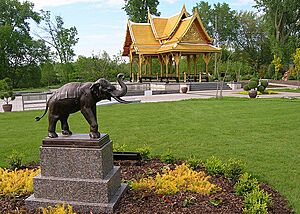
The Memorial Union is a central gathering place on Lake Mendota. Memorial Union Terrace is home to uniquely designed "terrace chairs" with a sunburst design that have become a symbol of the city. The Memorial Union hosts concerts, plays, and comedy and is home to multiple restaurants and ice cream shops serving both the University of Wisconsin–Madison campus and the greater city.
Henry Vilas Zoo is a 28-acre (11 ha) public zoo owned by Dane County which receives over 750,000 visitors annually. It is one of ten remaining free zoos in North America.
Olbrich Botanical Gardens contains a 16-acre outdoor botanical garden and 10,000-square-foot conservatory. Founded in 1952 and named for its founder, Michael Olbrich, the gardens are owned and operated jointly by the City of Madison Parks and the non-profit Olbrich Botanical Society. Noteworthy is the Thai sala, a gift to the University of Wisconsin–Madison from the Thai Chapter of the Wisconsin Alumni Association and the government of Thailand through its king, Bhumibol Adulyadej.
Art museums include the University of Wisconsin–Madison's Chazen Museum of Art and the Madison Museum of Contemporary Art, which annually organizes the Art Fair on the Square. Madison also has independent art studios, galleries, and arts organizations, with events such as Art Fair Off the Square. Other museums include Wisconsin Historical Museum (run by the Wisconsin Historical Society), the Wisconsin Veterans Museum, the LR Ingersoll Physics Museum, and the Madison Children's Museum.
Architecture
Madison's architectural landmarks reflect a wide range of styles, ranging from the first Usonian house designed by modern architect Frank Lloyd Wright to imposing brutalist buildings on the campus of UW–Madison and art deco towers interspersed through the downtown. Some of the most prominent buildings on the skyline include the Beaux-Arts Wisconsin State Capitol, the Renaissance Revival University of Wisconsin Memorial Union, the Wright-designed Monona Terrace, and the postmodern Overture Center for the Arts designed by César Pelli.
The height of Madison's skyline is limited by a state law that restricts building heights in the downtown area. All buildings within one mile (1.6 km) of the Wisconsin State Capitol have to be less than 1,032.8 feet (314.8 m) above sea level to preserve the view of the building from most areas of the city. The Wisconsin State Capitol dome was modeled after the dome of the U.S. Capitol, and was erected on the high point of the isthmus. Capitol Square is located in Madison's urban core.
Prairie and Usonian
Madison is home to eight buildings designed by influential Wisconsin-born modern architect Frank Lloyd Wright, more than any city outside of the Chicago metropolitan area. Wright, who spent much of his childhood in Madison and studied briefly at the University of Wisconsin–Madison, was based at Taliesin in nearby Spring Green for most of his career. His designs in Madison include the city's lakefront convention center, Monona Terrace, as well as Wright's first Usonian house, the Herbert and Katherine Jacobs First House, which is a UNESCO World Heritage Site.
Other well-known prairie style and usonian architects Louis Sullivan and Claude and Starck also have well known buildings in the city. The Harold C. Bradley House in the University Heights neighborhood was designed collaboratively by Sullivan and George Grant Elmslie in 1908–1910. Claude and Starck designed over 175 Madison buildings, and many are still standing, including Breese Stevens Field, Doty School (now condominiums), and many private residences.
Brutalist
Madison, and especially the UW–Madison campus, have numerous buildings in the brutalist style. These structures include the George L. Mosse Humanities Building designed by Harry Weese and the Chazen Museum of Art.
Art Deco
Downtown Madison is home to numerous examples of the art deco and art moderne styles. Examples include Quisling Terrace, where rounded corners and terracing adorn a medical clinic turned condominium, and Tenney Plaza, where lake views, marble and brass lobby details, and vertical lines mark the first steel frame high rise in the city. The art deco State Office Building is the tallest office building in the city. It was built in 1931 and is listed on the National Register of Historic Places. The Orpheum Theater is located on State Street one block from the capital. This Art Deco building was added to the National Register of Historic Places as Madison's best surviving representative of the movie palace era.
Cuisine

Madison's proximity to fertile lands and the city's ethnic history play an important role in defining the city's cuisine, which is marked by dairy; farm-to-table fine dining; German, Scandinavian, and Hmong cuisine; and the consumption of alcohol.
The land surrounding Madison is home to a numerous dairy farms, which leads to a dairy heavy cuisine. The Combined Statistical Area host numerous cheesemakers, including the award-winning Uplands Cheese, Hooks Cheese Company, and Landmark Creamery. Restaurants in Madison often feature cheese curds served either fried with dipping sauce, such as ranch dressing or "squeaky" (not cooked, so called because of the squeaking sound they often make against the teeth when chewed), usually served without dipping sauce. Another popular food is hot and spicy cheese bread, made by some Madison bakeries and available at farmer's markets around the city. Beer cheese soup is a favorite wintertime comfort food.
Other agricultural activity in the Madison area involves the growing of fruits like cranberries and popular vegetables, including snap beans, carrots, corn and potatoes. On Saturday mornings in the summer, the Dane County Farmers' Market is held around Capitol Square, the largest producer-only farmers' market in the country. A smaller version of this market is held on Martin Luther King Boulevard on Wednesdays during the summer. In late fall, this market moves indoors, first as the Holiday Market at the Monona Terrace. Later it becomes the Late Winter Market at the Madison Senior Center. This market attracts numerous vendors who sell fresh produce, meat, cheese, and other products. The popularity of fresh and local produce has led to a farm-to-table culture in Madison—the city is home to several James Beard Award winners, gastropubs, and farm-to-table restaurants.
Madison is home to numerous Wisconsin-style supper clubs. An all-you-can-eat Friday night fish fry is particularly common at Wisconsin supper clubs, as are old fashioned cocktails. Some restaurants in Madison follow the general Wisconsin supper club practice of restaurants serving "Friday fish fry, Saturday prime rib special, Sunday chicken dinner special."
Madison's ethnic history has a strong influence on the city's cuisine. German immigrants to Madison in the late 19th and early 20th century brought with them a strong culinary tradition. Multiple restaurants in Madison are modeled after German-style beer halls. Some restaurants participate in twice-monthly (from June to October, once a month otherwise) Bavarian smorgasbord. Madison is home to a large Hmong population, leading to a variety of Laotian and Hmong restaurants that make the city a "national hub of Hmong cuisine". The city is home to unique foods such as the large spring rolls sold from the food carts on Capital Square and State Street, particularly in warmer months.
Events
Madison is home to the World's Largest Brat Fest which sells over 200,000 bratwurst sausages annually during Memorial Day weekend.
The Great Taste of the Midwest craft beer festival, established in 1987 and the second-longest-running such event in North America, is held the second Saturday in August. The highly coveted tickets sell out within an hour of going on sale in May.
Music
Madison's music scene covers a spectrum of musical culture. Several venues offer live music nightly, spreading from the historic Barrymore Theatre and High Noon Saloon on the east side to small coffee houses and wine bars. The biggest headliners sometimes perform at the Orpheum Theatre, the Overture Center, Breese Stevens Field, the Alliant Energy Center, or the UW Theatre on campus. Other major rock and pop venues include the Majestic Theatre, the Sylvee, and The Bartell. During the summer, the Memorial Union Terrace on the University of Wisconsin campus, offers live music five nights a week. The Union is located on the shores of Lake Mendota.
In the summer, Madison hosts many music festivals. Concerts on the Square is a weekly Madison tradition during the summer. On Wednesday evenings, the Wisconsin Chamber Orchestra performs free concerts on the capitol's lawn, and people come to listen to the music while picnicking on the grass. Other annual music events include the Waterfront Festival, the Willy Street Fair, Atwood Summerfest, the Isthmus Jazz Festival, the Orton Park Festival, 94.1 WJJO's Band Camp, Greekfest, the WORT Block Party and the Sugar Maple Traditional Music Festival, and the Madison World Music Festival. One of the latest additions is the La Fete de Marquette, taking place around Bastille Day at various east side locations and celebrating French music with Cajun influences. Madison also hosts an annual electronic music festival, Reverence, and the Folk Ball, a world music and Folk dance festival held annually in January. Madison also plays host to the National Women's Music Festival. UW-Madison also hosts the annual music and arts festival, Revelry, on campus at the Memorial Union each spring. The festival is put on by students for students as an end of the year celebration on campus.
The Madison Scouts Drum and Bugle Corps is a competitive drum corps group based in Madison that competes and tours across North America as part of Drum Corps International. The University of Wisconsin Marching Band performs at various local concerts and parades.
Madison has a lively independent rock scene, and local independent record labels include Crustacean Records, Science of Sound, Kind Turkey Records, and Art Paul Schlosser Inc. Madison was home to Smart Studios, Butch Vig and Steve Marker's longtime studio where many notable alternative rock records of the 1990s and 2000s were recorded and/or produced. A Dr. Demento and weekly live karaoke favorite is The Gomers. They have performed with fellow Wisconsin residents Les Paul and Steve Miller.
..... The band Garbage formed in Madison in 1994, and has sold 17 million albums.
Nightlife
Much of the city's nightlife is centralized to the downtown area which includes a variety of bars, restaurants, and performance venues. State Street and the surrounding area are popular with tourists and University of Wisconsin-Madison students. Venues in the Capital Square neighborhood are popular with local young professionals and provide many happy hour specials. Another center of nightlife is the Williamson (Willy) Street Neighborhood. Madison is also home to a number of nightclubs, gay bars and live music venues. The Mifflin Street Block Party and the Freakfest Halloween Party also attract thousands of partygoers.
Performing arts
The Madison Opera, the Madison Symphony Orchestra, Forward Theater Company, the Wisconsin Chamber Orchestra, and the Madison Ballet are some of the professional resident companies of the Overture Center for the Arts. The city is also home to a number of smaller performing arts organizations, including a group of theater companies that present in the Bartell Theatre, a former movie palace renovated into live theater spaces, and Opera for the Young, an opera company that performs for elementary school students across the Midwest. Music Theatre of Madison is a professional musical theater company that performs new and lesser-known musicals in a variety of venues. The Wisconsin Union Theater (a 1,300-seat theater) is home to seasonal attractions and is the main stage for Four Seasons Theatre, a community theater company specializing in musical theater, and other groups. The Young Shakespeare Players, a theater group for young people, performs uncut Shakespeare and George B. Shaw plays.
Community-based theater groups include Children's Theatre of Madison, Strollers Theatre, Madison Theatre Guild, the Mercury Players, and Broom Street Theater (which is no longer on Broom Street).
Madison has one comedy club, Comedy on State (which has hosted the Madison's Funniest Comic competition every year since 2010), owned by the Paras family. Madison has other options for more alternative humor, featuring several improv groups, such as Atlas Improv Company, Monkey Business Institute, and open mic nights.
Madison is home to a large entertainment industry archive at the Wisconsin Center for Film and Theater Research, part of the Wisconsin Historical Society.
Other cultural events
Madison was host to Rhythm and Booms, a large fireworks celebration coordinated to music. It began with a fly-over by F-16s from the local Wisconsin Air National Guard. This celebration was the largest fireworks display in the Midwest in length, number of shells fired, and the size of its annual budget. Effective 2015, the event location was changed to downtown and renamed Shake The Lake.
There are several cooperative organizations in the Madison area, ranging from grocery stores (such as the Willy Street Cooperative) to housing co-ops (such as Madison Community Cooperative and Nottingham Housing Cooperative) to worker cooperatives (including an engineering firm, a wholesale organic bakery and a cab company).
Every April, the Wisconsin Film Festival is held in Madison. This five-day event features films from a variety of genres shown in theaters across the city. The University of Wisconsin–Madison Arts Institute sponsors the Film Festival.
Madison's official bird is the plastic flamingo, a type of lawn ornament. The city council adopted the plastic flamingo in 2009 following a campaign by a local newspaper columnist in reference to a 1979 prank by UW–Madison students who planted 1,008 plastic flamingos on Bascom Hill. The flamingo appears in the logo of the city's professional soccer team, Forward Madison FC.
Sports
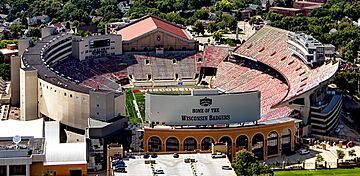
| Club | Sport | League | Venue | Founded |
|---|---|---|---|---|
| Wisconsin Badgers | Various | NCAA | Camp Randall Stadium, Kohl Center | 1849 |
| Madison Night Mares | Softball | Northwoods League | Warner Park | 2024 |
| Madison Mallards | Baseball | Northwoods League | Warner Park | 2001 |
| Madison Radicals | Ultimate | AUDL | Breese Stevens Field | 2013 |
| Madison Capitols | Ice Hockey | United States Hockey League | Bob Suter's Capitol Ice Arena | 2014 |
| Forward Madison FC | Soccer | USL League One | Breese Stevens Field | 2018 |
| Forward Madison FC | Soccer | USL Super League | Breese Stevens Field | 2025 |
| LOVB Madison | Volleyball | League One Volleyball | Wisconsin Field House, Alliant Energy Center | 2024 |
Madison is known for having its athletics fan base centered on the University of Wisconsin–Madison, whose teams compete as the Wisconsin Badgers in venues in and around the city. The Wisconsin Badgers football team plays at Camp Randall Stadium where crowds of as many as 83,000 have attended games. The Wisconsin Badgers men's basketball and Wisconsin Badgers men's ice hockey teams play at the Kohl Center. Construction on the $76 million arena was completed in 1997. The Wisconsin Badgers women's ice hockey team plays at the LaBahn Arena. Some events are played at the county-owned Alliant Energy Center (formerly Dane County Memorial Coliseum) and the university-owned Wisconsin Field House.
In 2014, the Madison Capitols made their return to the Madison area following 19 years of dormancy. The Capitols play their home games at Bob Suter's Capitol Ice Arena following three years at Alliant Energy Center.
On May 17, 2018, it was announced that Forward Madison FC would become Madison's first professional soccer team, and are members of USL League One. They play their home matches at the historic Breese Stevens Field.
Madison is home to the Madison Mallards, a college wood-bat summer baseball league team in the Northwoods League. They play in Warner Park on the city's north side from June to August.
Former teams
The Madison Muskies, a Class A, Midwest League affiliate of the Oakland A's, left town in 1993 after 11 seasons. The Madison Hatters, another Class A, Midwest League team, played in Madison for only the 1994 season. The Madison Black Wolf, an independent Northern League franchise lasted five seasons (1996–2000), before decamping for Lincoln, Nebraska.
Amateur sports
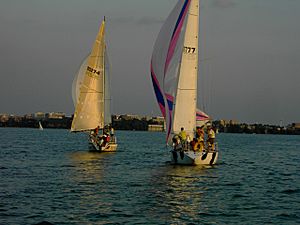
Madison has several active ultimate disc leagues organized through the nonprofit Madison Ultimate Frisbee Association. In 2013, the Madison Radicals, a professional ultimate frisbee team, debuted in the city.
Madison is home to several endurance sports racing events, such as the Crazylegs Classic, the CrossFit Games, Paddle and Portage, the Mad City Marathon, and Ironman Wisconsin, which attracts over 45,000 spectators.
The Wisconsin Rugby Club, the 1998 and 2013 USA Rugby Division II National Champions, and the Wisconsin Women's Rugby Football Club are the state's only Division I women's rugby team.
The Madison Curling Club was founded in 1921. Team Spatola of the Madison Curling Club won the 2014 Women's US National Championship. Team members are: Nina Spatola, Becca Hamilton, Tara Peterson, Sophie Brorson.
Madison's Gaelic sports club hosts a hurling team organized as the Hurling Club of Madison and a Gaelic football club with men's and women's teams.
The roller derby league, Madison Roller Derby, was formed in Madison in 2004 and is a member of the Women's Flat Track Derby Association. Madison is also home to Wisconsin United Roller Derby, a member league of the Men's Roller Derby Association.
The Blackhawk Ski Club, formed in 1947, provides ski jumping, cross country skiing and alpine skiing. The club's programs have produced several Olympic ski jumpers, two Olympic ski jumping coaches and one Olympic ski jumping director. The club had the first Nordic ski facility with lighted night jumping.
As of 2017, the CrossFit Games have been held at the Alliant Energy Center. After seven years at the StubHub Center in Carson, California, the Games moved to Madison for an initial three-year contract. CrossFit chose the multi-building entertainment venue, which encompasses 164 acres (0.66 km2), after posting a national request for proposals.
Parks and recreation
Madison has 6,431 acres (26.03 km2) of park space, which is 13.5% of the city's total area. Parks in the city include James Madison Park, which has views of Lake Mendota; Frank W. Hoyt Park, which is listed on the National Register of Historic Places; Garner Park, where the Madison Opera holds an "Opera in the Park" event; and Warner Park, which is home to the stadium for the Madison Mallards baseball team.
Goodman Pool is Madison's public outdoor swimming pool.
The University of Wisconsin–Madison Arboretum manages 520 acres (210 ha) of remnant forests and prairies throughout Wisconsin. The 300-acre (1.2 km2) Lakeshore Nature Preserve preserves native species along the southern shore of Lake Mendota.
During the winter months, sports enthusiasts enjoy ice boating, ice skating, ice hockey, ice fishing, cross-country skiing, and snowkiting. During the rest of the year, outdoor recreation includes sailing on the local lakes, bicycling, and hiking.
Madison is known for its extensive biking infrastructure, with numerous bike paths and bike lanes throughout the city. Several of these bike paths connect to state trails, such as the Capital City State Trail, Military Ridge State Trail, and Badger State Trail. In addition to these bike paths, most city streets have designated bike lanes or are designated as bicycle boulevards, which give high priority to bicyclists. In 2015 Madison was awarded platinum level Bicycle Friendly Community designation from the League of American Bicyclists, one of only five cities in the US to receive this (highest) level.
Education
The Madison Metropolitan School District serves the city while a variety of other districts serve the surrounding area. With an enrollment of approximately 25,000 students in 46 schools, it is the second largest school district in Wisconsin behind the Milwaukee School District. The five public high schools are Vel Phillips Memorial, Madison West, Madison East, La Follette, and Malcolm Shabazz City High School, an alternative school.
Among private church-related high schools are Abundant Life Christian School, Edgewood High School, near the Edgewood College campus, and St. Ambrose Academy, a Catholic school offering grades 6 through 12. Madison Country Day School is a private high school with no religious affiliation.
The city is home to the flagship campus of the University of Wisconsin, Edgewood College, Madison Area Technical College, and Herzing University-Madison, giving the city a post-secondary student population of nearly 65,000. The University of Wisconsin accounts for the vast majority of students, with an enrollment of roughly 50,000, of whom 37,000 are undergraduates.
Additional degree programs are available through satellite campuses of Concordia University-Wisconsin, Lakeland College, the University of Phoenix, and Upper Iowa University. Madison also has a non-credit learning community with multiple programs and many private businesses also offering classes.
Media
Madison is home to an extensive and varied number of print publications, reflecting the city's role as the state capital and its diverse political, cultural and academic population. The Wisconsin State Journal (weekday circulation: ~95,000; Sundays: ~155,000) is published in the mornings, while its sister publication, The Capital Times (Thursday supplement to the Journal) is published online daily, with two printed editions a week. Though jointly operated under the name Capital Newspapers, the Journal is owned by the national chain Lee Enterprises, and the Times is independently owned. Wisconsin State Journal is the descendant of the Wisconsin Express, a paper founded in the Wisconsin Territory in 1839. The Capital Times was founded in 1917 by William T. Evjue, a business manager for the State Journal who disagreed with that paper's editorial criticisms of Wisconsin Republican Senator Robert M. La Follette, Sr. for his opposition to U.S. entry into World War I.
The free weekly alternative newspaper Isthmus (weekly circulation: ~65,000) was founded in Madison in 1976. The Onion, a satirical weekly, was founded in Madison in 1988 and published from there until it moved to New York in 2001. Two student newspapers are published during the academic year, The Daily Cardinal (Mon–Fri circulation: ~10,000) and The Badger Herald (Mon–Fri circulation: ~16,000). Other specialty print publications focus on local music, politics and sports, including The Capital City Hues, The Madison Times, Madison Magazine, The Simpson Street Free Press, Umoja Magazine, and fantasy-sports web site RotoWire.com. Local community blogs include Althouse and dane101.
Madison is associated with "Fighting Bob" La Follette and the Progressive movement. La Follette's magazine, The Progressive, founded in 1909, is still published in Madison. It is a far left-wing periodical that may be best known for the attempt of the U.S. government in 1979 to suppress one of its articles before publication. The magazine eventually prevailed in the landmark First Amendment case, United States v. The Progressive, Inc. During the 1970s, there were two radical weeklies published in Madison, known as TakeOver and Free for All, as well as a Madison edition of the Bugle-American underground newspaper.
Radio
Madison has three large media companies that own the majority of the commercial radio stations within the market. These companies consist of iHeartMedia, Entercom Communications, and Mid-West Family Broadcasting as well as other smaller broadcasters. Madison is home to Mid-West Family Broadcasting, which is an independently owned broadcasting company that originated and is headquartered in Madison. Mid-West Family owns radio stations throughout the state and the Midwest.
Madison hosts two volunteer-operated and community-oriented radio stations, WORT and WSUM. WORT Community Radio (89.9 FM), founded in 1975, is one of the oldest volunteer-powered radio stations in the United States. A listener-sponsored community radio station, WORT offers locally produced diverse music and talk programming. WSUM (91.7 FM) is a free-form student radio station programmed and operated almost entirely by students.
Madison's Wisconsin Public Radio station, WHA, was one of the first radio stations in the nation to begin broadcasting. Public radio programs that originate at the WPR studios include Michael Feldman's Whad'Ya Know?, Zorba Pastor On Your Health, To the Best of Our Knowledge, Calling All Pets, and the longest running radio program in America, Chapter a Day.
WXJ-87 is the NOAA Weather Radio All Hazards station on Madison's west side, with broadcasts originating from the National Weather Service in Sullivan, Wisconsin.
TV
Madison has six commercial stations, two public television stations and a religious station. The commercial stations consist of WISC-TV (CBS) and its MyNetworkTV subchannel, TVW; WMTV (NBC), with a CW+ subchannel; WKOW-TV (ABC); WMSN-TV (Fox); WIFS (Ion); and WZCK-LD/W23BW-D (various subchannel networks). WMWD-LD (Daystar) also serves the area. Madison has two public television stations: WHA-TV, which is owned by the University of Wisconsin–Extension and airs throughout the state with the exception of Milwaukee, and cable's Madison City Channel, which is owned and operated by the City of Madison covering city governmental affairs.
Infrastructure
Transportation
Madison is served by the Dane County Regional Airport, which serves nearly 2.2 million passengers annually. Most major general aviation operations take place at Middleton Municipal Airport in Middleton 15 miles (24 km) from Madison's city center. Metro Transit operates bus routes throughout the city and to some neighboring suburbs.
Starting from the last decades of the 20th century, Madison has been among the leading cities for bicycling as a form of transportation, with about 3% of working residents pedaling on their journey to work. The share of Madison workers who bicycled to work increased to 5.3% by 2014. The 2016 survey by American Community Survey indicated that 65.7% of working Madison residents commuted by driving alone, 6.7% carpooled, 8.6% used public transportation, and 8.5% walked. About 6% used all other forms of transportation, including bicycles, motorcycles, and taxis. About 4.5% worked at home.
In 2015, 11.2% of Madison households were without a car, which was unchanged in 2016. The national average was 8.7% in 2016. Madison averaged 1.5 cars per household in 2016, compared to a national average of 1.8 per household.
Railways
Passenger train service between Madison and Chicago on the Sioux and the Varsity was provided by the Chicago, Milwaukee, St. Paul and Pacific Railroad (Milwaukee Road) until 1971. The Chicago and North Western Railway also provided service to the east side of Madison, ending in 1965.
The city is served by the Columbus Amtrak station 28 miles (45 km) to the northeast with once daily trains to Chicago, Portland, OR and Seattle, WA and stops in between via the Empire Builder route. Although located outside of the city proper, the station is listed on Amtrak timetables as Madison's official stop.
A high-speed rail route from Chicago through Milwaukee and Madison to Minneapolis–Saint Paul, Minnesota, was proposed as part of the Midwest Regional Rail Initiative. Funding for the railway connecting Madison to Milwaukee was approved in January 2010, but then Governor-elect Scott Walker's opposition to the project led the Federal Railroad Administration to retract the $810 million in funding and reallocate it to projects in other states.
Plans to establish Amtrak service within the city of Madison were revived in 2021. Pending federal legislative action, Madison is again slated to receive a rail link to Chicago via Milwaukee, likely with an expansion of the Hiawatha. Longer-term plans include a connection to the Twin Cities, potentially via Eau Claire; however, this has not been officially established. Anticipating eventual revival of passenger service, public meetings were held in early 2024 by the city's Department of Transportation to consider possible site(s) for the station.
Railroad freight services are provided to Madison by the Wisconsin and Southern Railroad (WSOR) and Canadian Pacific Kansas City (CPKC).
Buses
In addition to public transportation, regional buses connect Madison to Milwaukee, Chicago, Minneapolis–Saint Paul, and many other communities. Badger Bus, which connects Madison and Milwaukee, runs several trips daily. Greyhound Lines, a nationwide bus company, serves Madison on its Chicago, Milwaukee, and Minneapolis–Saint Paul route. Van Galder Bus Company, a subsidiary of Coach USA, provides transportation through Rockford to Chicago—stopping at Union Station, O'Hare Airport, and Midway Airport. Jefferson Lines provides transportation to Minneapolis–Saint Paul via La Crosse. Megabus provides limited-stop service to Chicago and Minneapolis–Saint Paul. Lamers Bus Lines has once-daily trips from Madison to Wausau, Dubuque, and Green Bay.
Highways
Interstate 39 (I-39), I-90 and I-94 run along the far east side of the city, connecting to Janesville to the south, Milwaukee to the east, and to Portage, La Crosse, Eau Claire, and Wausau heading north and northwest.
U.S. Highway 151 (US 151) runs through downtown and serves as the main thoroughfare through the northeast (as Washington Avenue) and south-central parts (as Park Street) of the city, connecting Madison with Dubuque, Iowa to the southwest and Fond du Lac and Manitowoc to the northeast.
US 12, frequently referred to by locals as the Beltline, is a six- to eight-lane freeway serving the south and west sides of Madison and is the main link from the western suburb of Middleton to Cambridge. Southeast of the area, US 12 connects to Lake Geneva, and going northwest, it heads to Wisconsin Dells.
US 18 is also a component highway of the Beltine, continuing south along US 151 and east towards Waukesha and Milwaukee.
Notable people
Nicknames
Over the years, Madison has acquired nicknames and slogans that include:
- Mad City
- Madtown
- The Berkeley of the Midwest
- 77 square miles surrounded by reality
- Four Lakes City
- People's Republic of Madison
Sister cities
Madison is twinned with:
See also
 In Spanish: Madison (Wisconsin) para niños
In Spanish: Madison (Wisconsin) para niños






